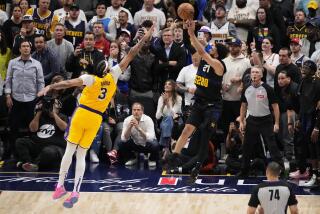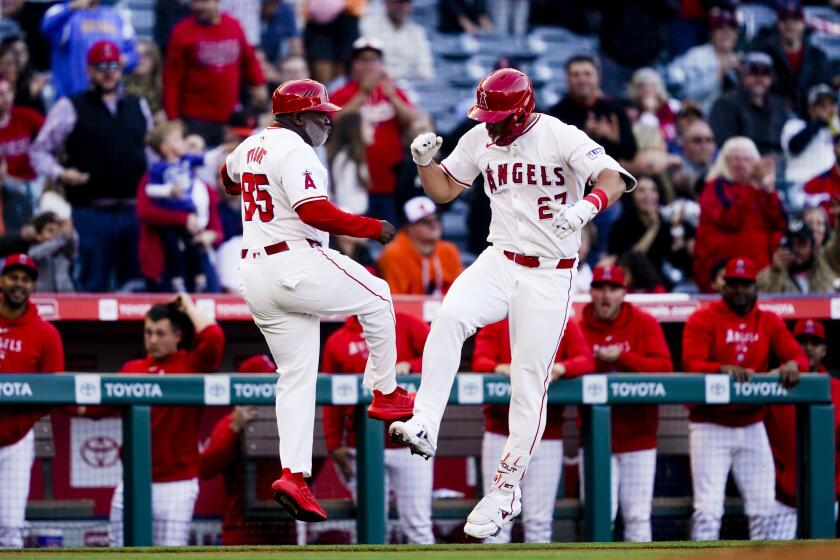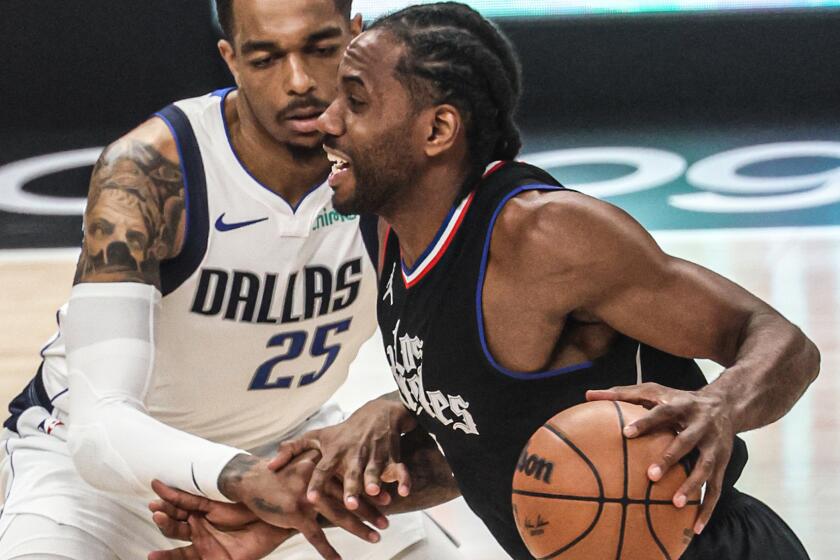Who’s Got Next?
A fledging pro sports league often needs 10 to 15 years before the public views it as a viable entity. And the sporting landscape is littered with failed attempts, from the World Football League to North American Soccer League.
The WNBA will complete its ninth season in September. It is considered, both in the U.S. and abroad, the best women’s pro basketball league. But its survival still depends heavily on NBA owners, who control 12 of the league’s 13 teams.
One of the biggest concerns of those paying the freight is how many people actually attend games. Ticket sales are crucial to the WNBA because it doesn’t have a plethora of corporate sponsors or a truckload of television revenue with which to pay salaries and operating costs.
And the numbers say there is a looming attendance problem in the league.
In the league’s first six seasons, WNBA attendance showed an increase, from 1,082,093 in 1997 to its peak 2,391,972 in 2002.
In 2003, the league went from 16 to 14 teams, and increased the regular-season schedule from 32 games to 34. It still drew more than 2 million fans, but the final total dipped to 2,100,630.
In 2004, the league contracted once more, to its present alignment of 13 teams. And in the past two seasons, attendance has flattened out. The 2004 season drew 1,899,106. This season’s final total was even less -- 1,806,362.
The WNBA’s attendance figures are a combination of tickets sold and complimentary tickets used. Which can mean the number announced at games may not always be the number actually in the house. All the above figures are from the regular season and do not include playoffs.
Put Spark President Johnny Buss among those feeling the pinch.
The best year for his team was 2002, when the Sparks averaged 11,651 a game. But the Sparks have had only one other season -- 2004 -- where they averaged 10,000 or more. This season, attendance fell nearly 2,000, from 10,428 in 2004, to 8,838.
“Our attendance has leveled off,” Buss said. “It would be one thing if it leveled off with the same interest. But it is diminished interest, and that concerns me. I really do think it is the way the games are played.”
Buss contends that, even though the league has arguably had its most competitive season ever -- with the playoff races in both conferences going down to the final weekend -- something is turning fans away.
“I see a lot less interest in the WNBA,” Buss said. “There’s the upside that people believe the league is here to stay and will catch a game at some point, but not so like they did when they first supported the league. Before they supported in it in greater numbers for its existence.
“On the negative side, I think the rules and the way the game is actually played has become boring. The ability to have more exciting games has been taken away. ... Referees are calling games so tightly it is taking away from excitement. They are slowing the game to a boring level. And the ability to make rule changes are still in the hands of NBA, and that is wrong.”
But there are success stories.
Washington and New York have consistently been the league’s top drawing franchises. The Mystics, who joined the WNBA in 1998, have led the league in attendance six times. The Liberty has led the league twice, including this year, and has been second in attendance six times.
Two other teams are showing gains in fan support.
Indiana, which entered the league in 2000, had a 10% jump in attendance this season from last year. Its 8,382 average ended a four-year decline.
General Manager Kelly Krauskopf said an aggressive push for season-ticket sales and constant interaction between players and the Indianapolis community during the off-season paid off.
“The main contributor is our team,” said Krauskopf, noting the Fever’s winning season. “The second part is we really focused hard on rebuilding the season-ticket base, because there is a natural attrition. We told people if they would buy full season tickets in January we would pay for the parking. That is a big deal for WNBA fans. That is how we built our base back.”
And then there’s Connecticut.
The franchise was purchased by the Mohegan Sun casino, located in Uncasville, Conn., and moved there from Orlando, Fla., in 2003. In its first two seasons the Sun was last in attendance, drawing less than 6,700 a game. But this season the figure rose to 7,173. More impressive is Connecticut has the best walk-up ticket sales in the league, averaging more than 1,000 on game day.
“We have the smallest arena in the league, so we should have the smallest attendance,” said General Manager Chris Sienko, whose arena has a capacity of 9,341. “We’re also the 25th largest market in country. But this year ... our season tickets, mini-plans and walk-up sales all increased.”
Another difference: Connecticut is the only team not owned by an NBA franchise.
“We never assumed people would just come because women’s hoops here are so well supported,” said Sienko, referring to the fanatical following enjoyed by the University of Connecticut women’s team. “But if you go back to ABL days [when Connecticut previously had a team], those supporters were used to seeing the game in the winter months. In summer they want to be outside. We figured we needed a good three to five years to grow our product. And we are ahead of schedule, off the court as well as on the court.”
WNBA President Donna Orender, who took over this season for founding president Val Ackerman, continues to stress patience. No professional league, from the NFL to Major League Baseball, has been an automatic hit out of the gate, she said. And those other male-dominated sports have had many more years to build and develop a strong following than women’s sports have had.
“The growth of women’s athletics is a much more recent phenomenon,” Orender said. “Not only are we now in a culture that is now encouraging young women to participate, there are unbelievably potent results from Title IX. Now we have this new demographic segment participating in sports in numbers we hadn’t seen before.”
But Orender, who brings a reputation from her days at the PGA Tour for building up sports businesses, realizes the league must combat the notion and data that interest is dwindling.
“As soon as we get through the season, we will sit down and strategically map out what we want to do regarding attendance,” Orender said. “We want filled arenas. How we map out that process will take a little time.”
And even Buss is measuredly optimistic about the league’s future.
“There are plenty of positives,” he said. “People will come if the game is exciting and there are more promotions and more games on the weekend.
“There are lots of positives on horizon, but they’re still on the horizon.”
*
(BEGIN TEXT OF INFOBOX)
Down the charts
WNBA and Sparks attendance figures from 1997 through 2005
(* Sparks played at the Forum):
WNBA
*--* YEAR GAMES TOTAL AVERAGE 1997 112 1,082,093 9,662 1998 150 1,629,602 10,864 1999 192 1,956,281 10,189 2000 256 2,322,429 9,072 2001 256 2,323,161 9,075 2002 256 2,391,972 9,344 2003 238 2,100,630 8,826 2004 221 1,899,106 8,593 2005 221 1,806,362 8,173
*--*
*
SPARKS
*--* YEAR GAMES TOTAL AVERAGE 1997* 14 125,034 8,931 1998* 15 114,088 7,606 1999* 16 122,000 7,625 2000* 16 105,005 6,563 2001 16 148,446 9,278 2002 16 186,410 11,651 2003 17 155,578 9,152 2004 17 177,269 10,428 2005 17 150,261 8,838
*--*
Source: Figures provided by the WNBA and kenn.com
*
WNBA playoffs
First-round matchups. All times Pacific (* if necessary):
WEST
No. 1 Sacramento vs. No. 4 Sparks
* Game 1: Wed., at Sparks, 7:30 p.m.
* Game 2: Fri., at Sacramento, 7 p.m.
* Game 3: Sun., at Sacramento, 6 p.m.*
No. 2 Seattle vs. No. 3 Houston
* Game 1: Tue., at Houston, 6:30 p.m.
* Game 2: Thu., at Seattle, 7 p.m.
* Game 3: Sat., at Seattle, 7 p.m.*
EAST
No. 1 Connecticut vs. No. 4 Detroit
* Game 1: Wed., at Detroit, 5 p.m.
* Game 2: Fri., at Connecticut, 5 p.m.
* Game 3: Sun., at Connecticut, 1 p.m.*
No. 2 Indiana vs. No. 3 New York
* Game 1: Tue., at New York, 4:30 p.m.
* Game 2: Thu., at Indiana, 5 p.m.
* Game 3: Sat., at Indiana, 4 p.m.*
More to Read
Get our high school sports newsletter
Prep Rally is devoted to the SoCal high school sports experience, bringing you scores, stories and a behind-the-scenes look at what makes prep sports so popular.
You may occasionally receive promotional content from the Los Angeles Times.






